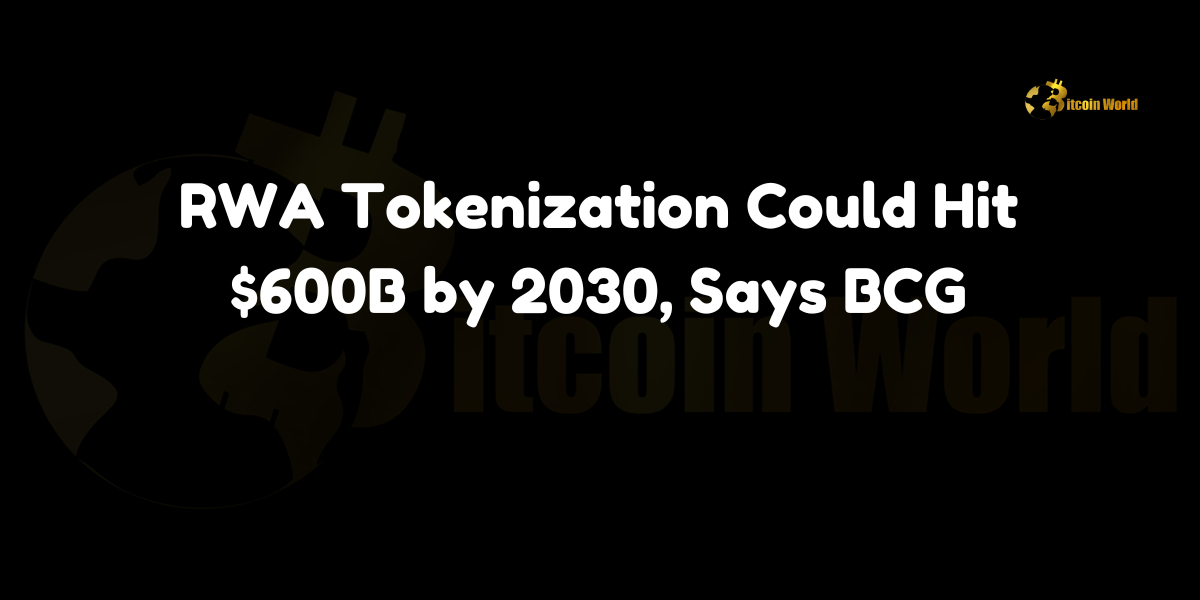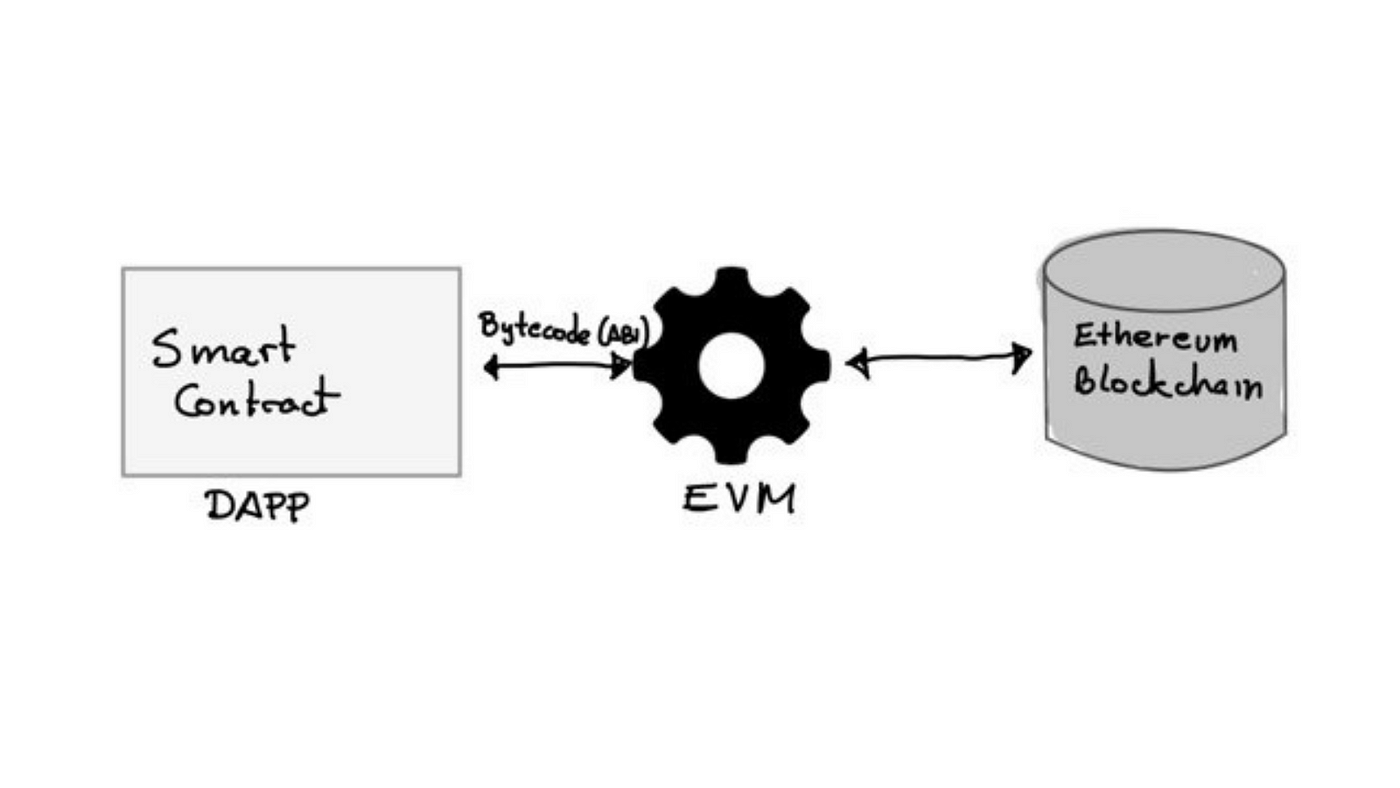Crptocurrency
RWA Tokenization Could Hit $600B by 2030, Says BCG

Real-world asset (RWA) tokenization is poised for substantial growth, with projections indicating that assets under management could soar to $600 billion by 2030. This optimistic forecast comes from a recent report by the Boston Consulting Group (BCG), as reported by Cointelegraph. David Chan, BCG Managing Director and Partner, emphasized the increasing investor demand for tokenized funds and highlighted the pivotal role of regulated stablecoins, tokenized deposits, and central bank digital currencies (CBDCs) in driving this expansion.
Introduction to RWA Tokenization
What is RWA Tokenization?
Real-world asset tokenization involves converting physical assets, such as real estate, commodities, and financial instruments, into digital tokens on a blockchain. This process enhances liquidity, accessibility, and transparency, allowing for fractional ownership and easier transfer of assets. By leveraging blockchain technology, RWA tokenization bridges the gap between traditional finance and decentralized finance (DeFi), opening up new avenues for investment and asset management.
Significance of the BCG Report
The Boston Consulting Group’s (BCG) report provides a comprehensive outlook on the future of RWA tokenization, underscoring its potential to revolutionize asset management. The projection of $600 billion in assets under management by 2030 reflects the growing confidence in blockchain-based solutions and the increasing acceptance of tokenized assets among institutional and retail investors alike.
Factors Driving the Growth of RWA Tokenization
Rising Investor Demand for Tokenized Funds
Investor appetite for tokenized funds is surging, driven by the desire for greater liquidity and diversified investment opportunities. Tokenized funds offer the benefits of traditional investment vehicles while providing the flexibility and efficiency of blockchain technology. This growing demand is a key driver behind the projected increase in RWA tokenization.
Regulated Stablecoins
Regulated stablecoins play a crucial role in the RWA tokenization ecosystem. By providing a stable and reliable medium of exchange, regulated stablecoins reduce the volatility associated with other cryptocurrencies, making them more attractive for institutional investors. These stablecoins facilitate seamless transactions and enhance the overall stability of tokenized asset markets.
Tokenized Deposits
Tokenized deposits are another significant factor contributing to the growth of RWA tokenization. By converting traditional deposit accounts into digital tokens, financial institutions can offer more flexible and accessible banking services. Tokenized deposits enable faster and more secure transactions, improving the efficiency of asset management and investment processes.
Central Bank Digital Currencies (CBDCs)
The introduction and adoption of Central Bank Digital Currencies (CBDCs) are expected to further drive the growth of RWA tokenization. CBDCs provide a regulated and secure digital currency framework, enhancing the credibility and trustworthiness of blockchain-based financial solutions. The integration of CBDCs with RWA tokenization platforms can facilitate smoother and more compliant asset tokenization processes.
Expert Insights
David Chan, BCG Managing Director and Partner
“The projection of $600 billion in assets under management through RWA tokenization by 2030 highlights the transformative potential of blockchain technology in traditional finance. The convergence of regulated stablecoins, tokenized deposits, and CBDCs creates a robust foundation for sustainable growth in the tokenization of real-world assets.”
Dr. Emily Carter, Blockchain Analyst
“RWA tokenization is set to redefine asset management by enhancing liquidity and democratizing access to investments. The integration of regulated stablecoins and CBDCs will address many of the regulatory and security concerns, making tokenized assets a viable option for a broader range of investors.”
Mark Thompson, Financial Strategist
“The increasing demand for tokenized funds indicates a shift in investor preferences towards more flexible and efficient investment vehicles. As the infrastructure for RWA tokenization continues to mature, we can expect significant advancements in how assets are managed and traded globally.”
Implications for the Financial Ecosystem
Enhanced Liquidity and Accessibility
RWA tokenization significantly enhances the liquidity of traditionally illiquid assets, such as real estate and fine art. By enabling fractional ownership and easier transferability, tokenized assets become more accessible to a wider pool of investors, including those who previously lacked the capital to invest in such assets.
Increased Transparency and Security
Blockchain technology ensures that all transactions involving tokenized assets are transparent and immutable. This increased transparency reduces the risk of fraud and enhances the security of asset transactions, fostering greater trust among investors and stakeholders.
Diversification of Investment Portfolios
Tokenized real-world assets allow investors to diversify their portfolios beyond traditional asset classes. This diversification can lead to more balanced and resilient investment strategies, mitigating risks associated with market volatility and economic downturns.
Regulatory Compliance and Standardization
The adoption of regulated stablecoins and CBDCs within the RWA tokenization framework promotes regulatory compliance and standardization. This alignment with regulatory requirements is essential for gaining institutional acceptance and ensuring the long-term viability of tokenized asset markets.
Future Outlook
Continued Technological Advancements
Advancements in blockchain technology, such as improved scalability and interoperability, will further facilitate the growth of RWA tokenization. These technological improvements will enable more efficient and seamless integration of real-world assets into the blockchain ecosystem.
Strategic Partnerships and Collaborations
Collaborations between financial institutions, blockchain platforms, and regulatory bodies will play a critical role in driving the adoption of RWA tokenization. Strategic partnerships can help establish industry standards, enhance regulatory frameworks, and promote the development of innovative tokenization solutions.
Global Expansion and Market Penetration
As RWA tokenization gains traction, we can expect a global expansion of tokenized asset markets. Emerging markets, in particular, present significant opportunities for RWA tokenization, as blockchain technology can address long-standing challenges related to asset management and financial inclusion.
Educational Initiatives and Investor Awareness
Educational initiatives aimed at increasing investor awareness and understanding of RWA tokenization will be crucial for its widespread adoption. By demystifying the complexities of blockchain technology and tokenized assets, more investors will be encouraged to participate in tokenized asset markets.
Conclusion
The Boston Consulting Group’s projection of $600 billion in assets under management through RWA tokenization by 2030 underscores the immense potential of blockchain technology to transform traditional finance. Driven by rising investor demand, regulated stablecoins, tokenized deposits, and CBDCs, RWA tokenization is set to revolutionize asset management by enhancing liquidity, accessibility, transparency, and security.
As the financial ecosystem continues to evolve, the integration of real-world assets with blockchain technology will create new opportunities for investors and financial institutions alike. By fostering innovation and promoting regulatory compliance, RWA tokenization will play a pivotal role in shaping the future of finance, driving sustainable growth, and fostering a more inclusive and efficient global financial system.
To stay updated on the latest developments in RWA tokenization and blockchain innovations, explore our article on latest news, where we cover significant events and their impact on the digital asset ecosystem.
Disclaimer: The information provided is not trading advice, Bitcoinworld.co.in holds no liability for any investments made based on the information provided on this page. We strongly recommend independent research and/or consultation with a qualified professional before making any investment decisions.
Crptocurrency
Altcoin Season Index Rises to 34, Indicating Continued Bitcoin Dominance

What the Altcoin Season Index Tells Us About Market Trends
The Altcoin Season Index is a helpful tool for investors, analysts, and crypto enthusiasts seeking to understand the balance of power between Bitcoin and altcoins in the market. By excluding stablecoins and wrapped tokens, the index provides a focused view of the performance of traditional altcoins, offering insights into market sentiment and capital flow.
During “Bitcoin Season,” investors tend to favor Bitcoin over other assets, resulting in increased Bitcoin dominance. Conversely, “Altcoin Season” is characterized by a shift in investor sentiment toward alternative cryptocurrencies, with at least 75% of the top 100 coins outperforming Bitcoin. Historically, Altcoin Season often follows periods of significant Bitcoin price growth, as investors begin to seek opportunities for higher returns in smaller, often more volatile, altcoins.
The current score of 34 indicates that while some altcoins are performing well, Bitcoin remains the most sought-after asset. This trend suggests that market participants are still cautious about diversifying heavily into altcoins, likely due to Bitcoin’s perceived stability and appeal as a store of value.
Understanding Bitcoin Season vs. Altcoin Season
Bitcoin Season and Altcoin Season reflect investor preferences within the cryptocurrency market, influenced by various economic, regulatory, and market conditions. Here’s how each season typically unfolds:
- Bitcoin Season: This occurs when Bitcoin outperforms most altcoins. Investors turn to Bitcoin for its stability, liquidity, and security. This often happens during periods of macroeconomic uncertainty or when Bitcoin itself is experiencing strong upward momentum. During Bitcoin Season, the Altcoin Season Index typically registers lower scores, reflecting a market skewed towards Bitcoin dominance.
- Altcoin Season: Defined by a higher Altcoin Season Index score (above 75), Altcoin Season occurs when most top altcoins outperform Bitcoin. Altcoin Season tends to attract investors looking for high-risk, high-reward opportunities, as altcoins often exhibit more volatility and potential for rapid gains. Historically, Altcoin Seasons have been fueled by periods of exuberance in the market, where speculation and interest in new, innovative projects reach peak levels.
With the index score currently at 34, the market is clearly in Bitcoin Season, as Bitcoin has outperformed the majority of altcoins over the past three months. This shift toward Bitcoin may be influenced by recent macroeconomic developments, regulatory changes, and evolving market sentiment.
Factors Contributing to Bitcoin’s Current Dominance
Several factors may be contributing to Bitcoin’s strong performance relative to altcoins, maintaining the market in Bitcoin Season:
- Macroeconomic Stability: In times of economic uncertainty, Bitcoin is often viewed as a more stable asset within the crypto space. As a decentralized and limited-supply asset, Bitcoin has earned a reputation as a hedge against inflation and economic instability. This appeal may drive investors toward Bitcoin rather than altcoins, which are generally considered riskier.
- Institutional Adoption: Bitcoin’s established position and institutional acceptance have bolstered its credibility. Major financial institutions and corporations have shown interest in Bitcoin, viewing it as a long-term investment. This growing institutional involvement provides stability to Bitcoin’s market and attracts investors who might otherwise avoid cryptocurrencies altogether.
- Regulatory Clarity: Bitcoin has faced fewer regulatory uncertainties than some altcoins, making it a safer option for risk-averse investors. While many altcoins are still under scrutiny by regulators, Bitcoin’s status as a decentralized digital asset has generally been accepted, giving it an advantage in terms of regulatory clarity.
- Market Sentiment and Safety: When investor sentiment shifts towards caution, there is often a “flight to safety” in the cryptocurrency market. This flight typically benefits Bitcoin, as it is perceived as a safer asset compared to more speculative altcoins. During periods of uncertainty, investors may choose to hold Bitcoin over other cryptocurrencies due to its perceived resilience and stability.
The Road Ahead: Could Altcoin Season Return?
Despite Bitcoin’s current dominance, Altcoin Season could still make a return, particularly if market conditions shift in favor of altcoins. Historically, Altcoin Season has followed periods of sustained Bitcoin growth, as investors seek alternative opportunities for high returns. Several conditions could facilitate the emergence of Altcoin Season, including:
- New Project Launches and Innovations: The launch of innovative altcoins with real-world use cases could drive investor interest toward altcoins, especially in sectors like decentralized finance (DeFi), gaming, and artificial intelligence. If these projects gain traction, they could outperform Bitcoin and push the market closer to Altcoin Season.
- Lower Bitcoin Volatility: If Bitcoin’s price stabilizes following a period of rapid growth, investors might look to altcoins for higher returns. Lower volatility in Bitcoin could lead to an increased appetite for risk among investors, driving capital into altcoins.
- Increased Market Liquidity: Higher liquidity in the crypto market, potentially driven by institutional participation, could make it easier for altcoins to experience sustained price growth. As liquidity increases, altcoins might benefit from the influx of capital and improved trading conditions.
- Positive Regulatory Developments for Altcoins: Should regulators adopt clearer guidelines or positive policies for altcoins, investor confidence could increase, creating favorable conditions for an Altcoin Season.
While Bitcoin currently dominates the market, the cyclical nature of the cryptocurrency space means that an Altcoin Season could still be on the horizon, especially if conditions align to favor alternative digital assets.
Conclusion
The Altcoin Season Index’s rise to 34 reflects a market that remains in Bitcoin Season, with Bitcoin outperforming most top altcoins over the past 90 days. This trend highlights investor preference for Bitcoin amid macroeconomic stability concerns, regulatory clarity, and market sentiment that favors the perceived safety of the leading cryptocurrency.
As market conditions evolve, an eventual shift to Altcoin Season could occur, especially if innovative projects and favorable regulatory changes attract capital toward altcoins. For now, however, Bitcoin remains at the center of attention, solidifying its role as the market leader in the cryptocurrency space.
To learn more about the innovative startups shaping the future of the crypto industry, explore our article on the latest news, where we delve into the most promising ventures and their potential to disrupt traditional industries.
Crptocurrency
A Guide to The Ethereum Virtual Machine (EVM)

Crptocurrency
South Korea’s Financial Regulator to Strengthen Oversight on Trump-Related Stocks and Crypto Volatility

-

 Startup Stories1 year ago
Startup Stories1 year agoWhy Millennials, GenZs Are Riding The Investment Tech Wave In India
-

 Startup Stories1 year ago
Startup Stories1 year agoStartups That Caught Our Eyes In September 2023
-

 Startup Stories1 year ago
Startup Stories1 year agoHow Raaho Is Using Tech To Transform India’s Fragmented Commercial Trucking
-

 Startup Stories1 year ago
Startup Stories1 year agoMeet The 10 Indian Startup Gems In The Indian Jewellery Industry’s Crown
-

 Crptocurrency8 months ago
Crptocurrency8 months agoLither is Making Crypto Safe, Fun, and Profitable for Everyone!
-

 Startup Stories1 year ago
Startup Stories1 year agoHow Volt Money Is Unlocking The Value Of Mutual Funds With Secured Lending
-

 Startup Stories1 year ago
Startup Stories1 year agoWhy Moscow-Based Kladana Considers Indian SME Sector As The Next Big Market For Cloud Computing
-

 E-commerce1 year ago
E-commerce1 year agoTop Online Couponing Trends To Watch Out For In 2016




